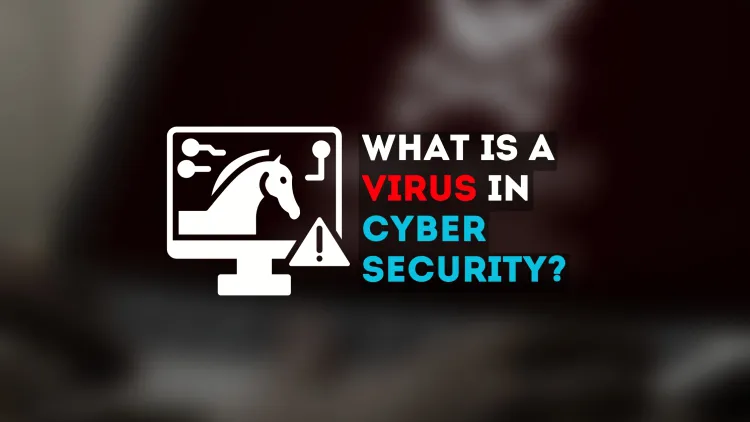What is a Virus in Cyber Security? The Complete Guide
A computer virus is a malicious program designed to disrupt systems and compromise data security. It spreads through infected files and executes when the host file is accessed. Understanding its types, signs of infection, and protective measures like antivirus software and firewalls can help you safeguard your systems effectively. Staying vigilant and informed is key to minimizing the risk of virus attacks.

In the realm of cybersecurity, a computer virus is a malicious program designed to disrupt, damage, or gain unauthorized access to systems and data. Just as biological viruses spread from host to host, a computer virus infects files or software, replicates itself, and spreads to other devices, leading to compromised performance and security.
How Does a Computer Virus Work?
A computer virus follows a series of steps to achieve its malicious intent:
- Infection: The virus attaches itself to a file, program, or document.
- Activation: When the infected file or program is executed, the virus activates.
- Replication: It copies itself and spreads to other files, programs, or devices.
- Damage: The virus disrupts system functionality by corrupting files, stealing data, or slowing down the system.
Types of Computer Viruses
1. File Infector Virus
- Attaches to executable files like
.exefiles. - Activates when the infected file is executed.
2. Macro Virus
- Targets files containing macros, such as Word and Excel documents.
- Spreads when the infected document is opened.
3. Boot Sector Virus
- Infects the boot sector of a storage device.
- Activates when the system starts.
4. Polymorphic Virus
- Changes its code each time it replicates to evade antivirus detection.
5. Resident Virus
- Hides in the computer's RAM, activating whenever the system operates.
Types of Computer Viruses
| Type | Target | Activation Point | Impact |
|---|---|---|---|
| File Infector Virus | Executable files | When file is run | Corrupts files, spreads easily |
| Macro Virus | Macro-enabled documents | When document is opened | Compromises document integrity |
| Boot Sector Virus | Boot sector of devices | System startup | Prevents system booting |
| Polymorphic Virus | Files and programs | Upon replication | Evades detection, spreads rapidly |
| Resident Virus | RAM | System operation | Persistent and hard to detect |
Signs of a Virus Infection
- System Slowdown: Decreased performance due to high resource consumption.
- Frequent Crashes: Programs or the entire system crash unexpectedly.
- Unusual Pop-ups: Random and excessive advertisements or error messages.
- Missing or Corrupted Files: Files mysteriously disappear or become inaccessible.
- Unauthorized Access: Unknown changes or access to your data.
How to Protect Against Computer Viruses
1. Install Antivirus Software
Use reputable antivirus programs to scan and remove viruses.
2. Regularly Update Software
Keep your operating system and applications up-to-date to patch vulnerabilities.
3. Avoid Suspicious Links and Downloads
Do not open unknown email attachments or click on unverified links.
4. Use Firewalls
Enable firewalls to block unauthorized access to your network.
5. Backup Data Regularly
Maintain backups to ensure data recovery in case of a virus attack.
Difference Between a Virus and Other Malware
| Characteristic | Virus | Worm | Trojan |
|---|---|---|---|
| Dependency | Requires a host file to spread | Spreads independently | Masquerades as legitimate |
| Primary Objective | Corrupt files or disrupt operations | Replicates rapidly to overload systems | Steals or damages data |
| Spread Method | Through infected files | Through networks and devices | Through misleading downloads |
Conclusion
A computer virus is a significant cybersecurity threat that can harm individuals and organizations alike. By understanding how viruses operate and implementing robust protective measures, such as using antivirus software, avoiding suspicious downloads, and maintaining regular backups, you can safeguard your data and systems. Stay informed and proactive to minimize the risks posed by these digital threats.
FAQs
-
What is a computer virus in cybersecurity?
A malicious program designed to disrupt, steal, or damage data and systems. -
How do viruses spread?
Through infected files, emails, downloads, or external devices. -
What are common types of viruses?
File infector, macro, boot sector, polymorphic, and resident viruses. -
What are signs of a virus infection?
Slow system performance, crashes, missing files, and unauthorized access. -
How can I protect my computer from viruses?
Use antivirus software, update regularly, and avoid suspicious links. -
What’s the difference between a virus and malware?
A virus is a type of malware that needs a host file to spread. -
Can antivirus software detect all viruses?
Most antivirus tools can detect known viruses but may struggle with new ones. -
What should I do if my computer gets infected?
Disconnect from the internet, run a virus scan, and remove the infected files. -
Is a worm more dangerous than a virus?
Worms spread faster but both can cause severe damage. -
Why is data backup important in virus protection?
Backups help you recover data if a virus deletes or corrupts files.











![Top 10 Ethical Hackers in the World [2025]](https://www.webasha.com/blog/uploads/images/202408/image_100x75_66c2f983c207b.webp)



![[2025] Top 100+ VAPT Interview Questions and Answers](https://www.webasha.com/blog/uploads/images/image_100x75_6512b1e4b64f7.jpg)







